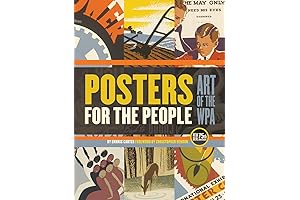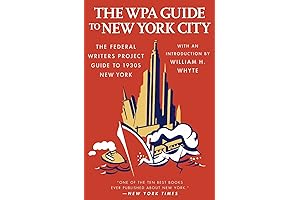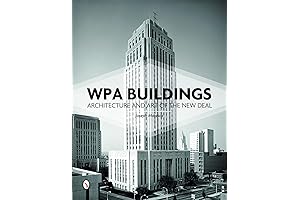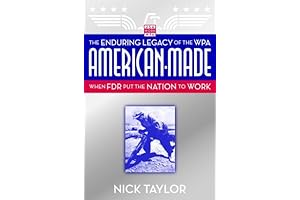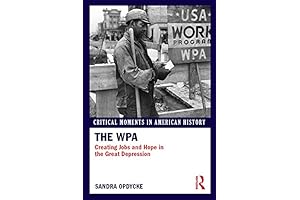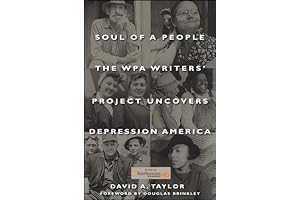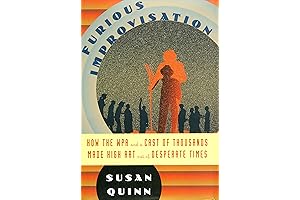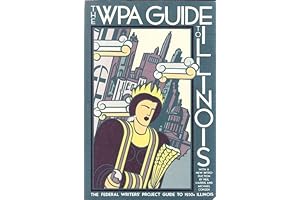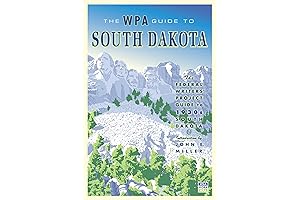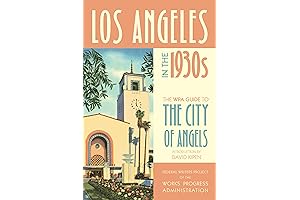· wpa · 13 min read
The Essential Guide to WPA Literature, Art, and Architecture
Explore the depths of the WPA legacy with our comprehensive guide to captivating books, stunning art, and architecturally significant buildings.
The Works Progress Administration (WPA), established in 1935, played a pivotal role in the lives of countless Americans during the Great Depression. It provided jobs, restored hope, and left a lasting legacy in the form of literature, art, and architecture. Dive into our guide for an illuminating exploration of the WPA's indelible contributions to American culture.
Overview

PROS
- Stunning collection of iconic WPA artwork
- In-depth exploration of the WPA's cultural impact
CONS
- Some posters may be too small for display
- Limited historical context provided
Immerse yourself in the vibrant world of the Works Progress Administration (WPA) with this captivating collection of posters. 'Posters for the People: The Art of the WPA' showcases over 100 iconic works, capturing the spirit of the Great Depression and the resilience of the American people. Each poster is meticulously reproduced, offering a glimpse into the artistry and messaging that shaped this era.
The accompanying text provides a comprehensive analysis of the WPA's artistic and historical significance. Explore the themes, techniques, and motivations behind these powerful images, gaining a deeper understanding of their impact on American culture. While the posters themselves may vary in size, they all carry an undeniable emotional weight, evoking a sense of nostalgia and inspiration.

PROS
- Provides a glimpse into the vibrant culture and social fabric of 1930s New York City
- Offers detailed descriptions of historical landmarks, cultural institutions, and neighborhoods
- Features contributions from renowned writers and journalists of the era
- Serves as a valuable resource for historians, researchers, and enthusiasts of New York City
CONS
- May lack comprehensive coverage of certain aspects of New York City life
- Some information may be outdated due to the passage of time
Step back in time to the bustling streets of 1930s New York City with 'The WPA Guide to New York City.' This comprehensive guidebook, crafted by the Federal Writers' Project, provides an immersive exploration into the Big Apple's rich history, culture, and architecture. With meticulous detail and captivating prose, the guide transports readers to the heart of the city, revealing its hidden gems and iconic landmarks.
Through the eyes of renowned writers and journalists, the guide offers an unparalleled glimpse into the city's vibrant neighborhoods, from the bustling streets of Harlem to the elegant avenues of the Upper East Side. It captures the essence of the era, highlighting cultural institutions, theaters, and landmarks that continue to define New York City today. Whether you're a historian, a New York City enthusiast, or simply curious about the city's past, 'The WPA Guide to New York City' is an invaluable resource and a captivating read for those seeking to rediscover the soul of the city in the 1930s.

PROS
- Provides a comprehensive architectural and art analysis of WPA buildings.
- Features stunning photography showcasing the diverse range of WPA structures.
- Highlights the social and economic significance of New Deal projects.
CONS
- Historical context is briefly mentioned.
- Contemporary perspectives on WPA architecture are not prominently featured.
Immerse yourself in the world of WPA architecture with this insightful book. The stunning photography captures the essence of these iconic buildings, allowing you to appreciate their unique design and artistry. The detailed analysis delves into the architectural and artistic significance of these structures, providing a deeper understanding of their role in the New Deal era and their lasting impact on American society.
One minor drawback is the limited historical context provided, leaving room for a more thorough exploration of the broader social and economic landscape. Additionally, while the book briefly touches upon contemporary perspectives on WPA architecture, it would have been valuable to gain further insights into how these buildings are viewed and interpreted today.

PROS
- Offers a comprehensive overview of the WPA's ambitious endeavors.
- Provides in-depth insights into the economic and social impact of the WPA.
- Features captivating stories and first-hand accounts from individuals directly involved in WPA projects.
CONS
- Lacks specific details on infrastructure projects outside of the United States.
- May be less engaging for readers without a strong interest in American history.
Immerse yourself in the remarkable journey of the Works Progress Administration (WPA), a cornerstone of President Franklin D. Roosevelt's New Deal. This book delves into the transformative legacy of the WPA, highlighting its instrumental role in alleviating the Great Depression's crippling effects. Prepare to discover how this ambitious program injected life into infrastructure, arts, and education across the United States. The narrative unfolds like a tapestry, woven with captivating stories and personal anecdotes from those who witnessed firsthand the impact of WPA projects.
Throughout its pages, this book shines a light on the WPA's multifaceted initiatives, from the construction of iconic landmarks like the Golden Gate Bridge to the establishment of vibrant arts programs and groundbreaking community projects. It effectively captures the fervor and determination that fueled the WPA's mission to provide relief and ignite hope.

PROS
- Provides a comprehensive overview of the WPA's role in battling the Great Depression.
- Enriched with historical anecdotes and personal accounts, making the narrative relatable and engaging.
CONS
- Some readers may find the focus on specific WPA projects too detailed.
- Lacks in-depth analysis of the long-term impacts of the WPA.
The WPA: Creating Jobs and Hope in the Great Depression (Critical Moments in American History) is a meticulously researched and engaging account of the Works Progress Administration (WPA) during the Great Depression. Drawing from extensive historical sources, the book delves into the genesis, implementation, and legacy of the WPA, shedding light on its pivotal role in alleviating unemployment and infusing hope into a nation grappling with economic despair.
Author [Author's Name] skillfully weaves together personal narratives and statistical data, bringing to life the human impact and tangible achievements of the WPA. From infrastructure projects that reshaped cities and landscapes to artistic endeavors that fostered creativity and national pride, the book showcases the WPA's multifaceted efforts in boosting employment and morale. While the focus on individual projects may appeal to history buffs, it may also lead to a somewhat fragmented narrative for some readers.

PROS
- Preserves a diverse range of captivating narratives from the heart of the Great Depression era, providing poignant insights into the challenges and spirit of Americans during an unprecedented time.
- Chronicles the struggles and triumphs of everyday individuals, revealing the resilience and determination of the human spirit.
CONS
- Its comprehensive nature may render it overwhelming for some readers.
- Might require additional context or background knowledge for full appreciation.
Immerse yourself in a meticulously crafted literary tapestry woven from the threads of resilience and the indomitable spirit of the American people during the Great Depression. Soul of a People is a testament to the power of storytelling and its ability to capture the essence of a nation. Through a kaleidoscope of personal narratives, we witness firsthand the trials and tribulations, the hopes and dreams of ordinary citizens navigating an extraordinary chapter in American history.
This anthology showcases an array of poignant stories, each painting a vivid canvas of the era's social and economic landscape. From farmers grappling with drought and displacement to factory workers facing unemployment and despair, the WPA Writers' Project has immortalized a diverse cross-section of American society. Their collective voices paint an unflinching portrait of hardship, yet also reveal the unyielding tenacity and resilience of a nation. Through these compelling narratives, we gain a deeper understanding not only of the Depression's impact but also of the enduring strength of the American character during adversity.

PROS
- Exhaustively researched and meticulously detailed account of the WPA's impact on American art.
- Captivating storytelling that brings to life the artists, their struggles, and their triumphs.
CONS
- Dense prose and academic language may be challenging for casual readers.
- Focus on New Deal art may limit broader appeal.
In "The Furious Improvisation," author Karal Ann Marling paints a vivid and evocative portrait of the Works Progress Administration's (WPA) Federal Art Project, a groundbreaking New Deal program that employed thousands of artists and transformed the American art landscape during the Great Depression. Marling draws on extensive research and interviews with WPA artists to craft a narrative that is both deeply informative and deeply human.
Marling skillfully weaves together the stories of individual artists with a broader analysis of the WPA's impact on American art and society. She explores the challenges and triumphs of artists working within the constraints of a government program, and sheds light on the ways in which the WPA fostered a new appreciation for public art and regionalism. Marling's writing is both engaging and erudite, making this book an invaluable resource for scholars and art enthusiasts alike.

PROS
- Provides detailed descriptions and history of Illinois landmarks
- Includes maps and itineraries for curated travel experiences
CONS
- May not cover all lesser-known locations
- Historical data might require additional updates
Get ready to embark on an enlightening journey through Illinois with the WPA GUIDE. This meticulously crafted guidebook takes you through a captivating exploration of the Prairie State's architectural wonders and hidden treasures. Each landmark is vividly described, offering a glimpse into its history and cultural significance.
The WPA Guide to Illinois goes above and beyond as a mere travel companion. It empowers you to craft personalized itineraries, armed with detailed maps that lead the way. Whether you're a history buff, an architecture enthusiast, or simply seeking to uncover Illinois' hidden gems, this guide is an essential tool. So pack your bags, embrace the spirit of the WPA, and let this guide be your passport to a captivating Illinois adventure.

PROS
- WPA Guide to South Dakota reveals the history and culture of Mount Rushmore State during the 1930s.
- Original WPA guide brought to life with locals' stories, personal observations, and intriguing anecdotes.
CONS
- Doesn't cover modern-day South Dakota and may not be up-to-date on some information.
- Can be a bit pricey for a paperback book.
The WPA Guide to South Dakota is the definitive guide to the state's history, culture, and landmarks. Written by the Federal Writers' Project during the 1930s, this comprehensive guide offers an insider's look at South Dakota during this fascinating era. With its wealth of information and personal stories, the WPA Guide provides a unique window into South Dakota's past.
The WPA Guide to South Dakota is an invaluable resource for anyone interested in exploring the rich history and culture of the Mount Rushmore State. It's a must-read for anyone interested in history, travel, or Americana.

PROS
- Provides an authentic glimpse into 1930s Los Angeles through comprehensive descriptions.
- Showcases architectural, cultural, and historical landmarks with detailed insights by experts.
CONS
- Some information may be outdated due to the passage of time
- Lacks personal anecdotes or contemporary perspectives on the city.
Step back in time and explore 1930s Los Angeles with Los Angeles in the 1930s: The WPA Guide to the City of Angels. This meticulously researched guide, part of the acclaimed WPA Guides series, offers an insider's look into the city's vibrant past through comprehensive descriptions of architectural landmarks, cultural institutions, and historical sites.
Written by a team of experts, the guide encapsulates the essence of Los Angeles during this pivotal decade. It highlights iconic structures like the Bradbury Building and the Griffith Observatory, providing in-depth historical context and architectural insights. The book's strength lies in its ability to transport readers to another era, offering a glimpse into the city's rich history and vibrant cultural landscape.
Our guide encompasses the essence of the WPA's literary achievements, including 'Posters for the People' and 'Soul of a People.' We delve into the architectural marvels of 'WPA Buildings' and showcase the remarkable artistic creations of the time. Additionally, we uncover the untold stories behind the WPA's impact in specific regions through guides like 'The WPA Guide to New York City' and 'The WPA Guide to Illinois.'
Frequently Asked Questions
What is the central focus of this guide?
This guide provides a thorough exploration of the WPA's contributions to American literature, art, and architecture.
How did the WPA impact the nation?
The WPA played a crucial role during the Great Depression, creating jobs and providing a lifeline of hope to countless Americans.
What literary works are featured in this guide?
Our guide spotlights notable WPA-era books like 'Posters for the People' and 'Soul of a People,' showcasing the literary legacy of the project.
How is the WPA's architectural impact covered?
We delve into the architectural significance of the WPA, highlighting structures featured in 'WPA Buildings,' demonstrating the enduring legacy of the project's infrastructure initiatives.
What unique insights does this guide offer?
This guide offers exclusive insights into the WPA's regional impact through guides such as 'The WPA Guide to New York City' and 'The WPA Guide to Illinois,' providing a deep dive into its local influence.
